Taehwan Kim
Grouped Differential Attention
Oct 08, 2025Abstract:The self-attention mechanism, while foundational to modern Transformer architectures, suffers from a critical inefficiency: it frequently allocates substantial attention to redundant or noisy context. Differential Attention addressed this by using subtractive attention maps for signal and noise, but its required balanced head allocation imposes rigid constraints on representational flexibility and scalability. To overcome this, we propose Grouped Differential Attention (GDA), a novel approach that introduces unbalanced head allocation between signal-preserving and noise-control groups. GDA significantly enhances signal focus by strategically assigning more heads to signal extraction and fewer to noise-control, stabilizing the latter through controlled repetition (akin to GQA). This design achieves stronger signal fidelity with minimal computational overhead. We further extend this principle to group-differentiated growth, a scalable strategy that selectively replicates only the signal-focused heads, thereby ensuring efficient capacity expansion. Through large-scale pretraining and continual training experiments, we demonstrate that moderate imbalance ratios in GDA yield substantial improvements in generalization and stability compared to symmetric baselines. Our results collectively establish that ratio-aware head allocation and selective expansion offer an effective and practical path toward designing scalable, computation-efficient Transformer architectures.
Towards Human-like Multimodal Conversational Agent by Generating Engaging Speech
Sep 18, 2025Abstract:Human conversation involves language, speech, and visual cues, with each medium providing complementary information. For instance, speech conveys a vibe or tone not fully captured by text alone. While multimodal LLMs focus on generating text responses from diverse inputs, less attention has been paid to generating natural and engaging speech. We propose a human-like agent that generates speech responses based on conversation mood and responsive style information. To achieve this, we build a novel MultiSensory Conversation dataset focused on speech to enable agents to generate natural speech. We then propose a multimodal LLM-based model for generating text responses and voice descriptions, which are used to generate speech covering paralinguistic information. Experimental results demonstrate the effectiveness of utilizing both visual and audio modalities in conversation to generate engaging speech. The source code is available in https://github.com/kimtaesu24/MSenC
Semi-Supervised Audio-Visual Video Action Recognition with Audio Source Localization Guided Mixup
Mar 04, 2025Abstract:Video action recognition is a challenging but important task for understanding and discovering what the video does. However, acquiring annotations for a video is costly, and semi-supervised learning (SSL) has been studied to improve performance even with a small number of labeled data in the task. Prior studies for semi-supervised video action recognition have mostly focused on using single modality - visuals - but the video is multi-modal, so utilizing both visuals and audio would be desirable and improve performance further, which has not been explored well. Therefore, we propose audio-visual SSL for video action recognition, which uses both visual and audio together, even with quite a few labeled data, which is challenging. In addition, to maximize the information of audio and video, we propose a novel audio source localization-guided mixup method that considers inter-modal relations between video and audio modalities. In experiments on UCF-51, Kinetics-400, and VGGSound datasets, our model shows the superior performance of the proposed semi-supervised audio-visual action recognition framework and audio source localization-guided mixup.
RingFormer: Rethinking Recurrent Transformer with Adaptive Level Signals
Feb 18, 2025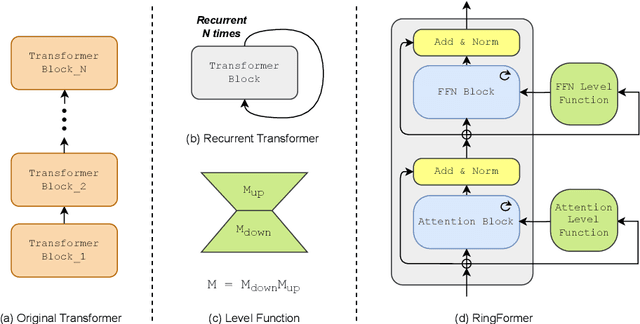
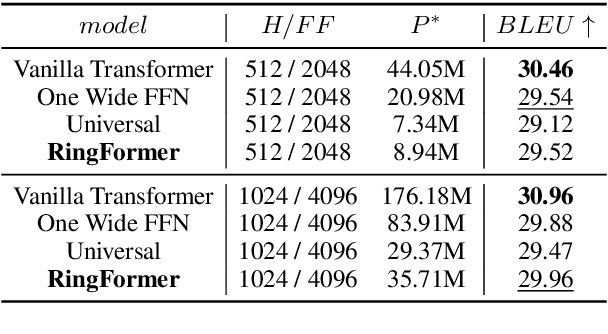
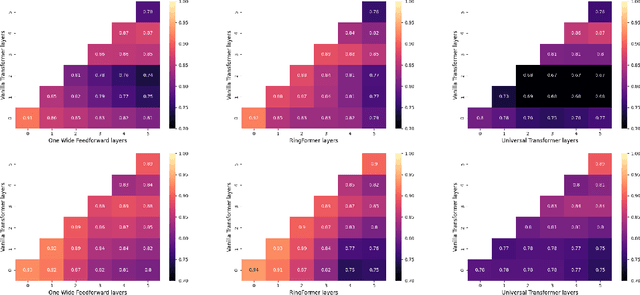
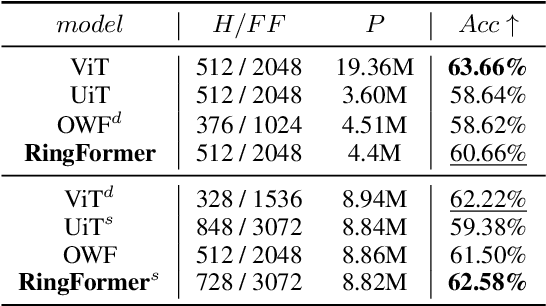
Abstract:Transformers have achieved great success in effectively processing sequential data such as text. Their architecture consisting of several attention and feedforward blocks can model relations between elements of a sequence in parallel manner, which makes them very efficient to train and effective in sequence modeling. Even though they have shown strong performance in processing sequential data, the size of their parameters is considerably larger when compared to other architectures such as RNN and CNN based models. Therefore, several approaches have explored parameter sharing and recurrence in Transformer models to address their computational demands. However, such methods struggle to maintain high performance compared to the original transformer model. To address this challenge, we propose our novel approach, RingFormer, which employs one Transformer layer that processes input repeatedly in a circular, ring-like manner, while utilizing low-rank matrices to generate input-dependent level signals. This allows us to reduce the model parameters substantially while maintaining high performance in a variety of tasks such as translation and image classification, as validated in the experiments.
Leveraging 2D Masked Reconstruction for Domain Adaptation of 3D Pose Estimation
Jan 14, 2025Abstract:RGB-based 3D pose estimation methods have been successful with the development of deep learning and the emergence of high-quality 3D pose datasets. However, most existing methods do not operate well for testing images whose distribution is far from that of training data. However, most existing methods do not operate well for testing images whose distribution is far from that of training data. This problem might be alleviated by involving diverse data during training, however it is non-trivial to collect such diverse data with corresponding labels (i.e. 3D pose). In this paper, we introduced an unsupervised domain adaptation framework for 3D pose estimation that utilizes the unlabeled data in addition to labeled data via masked image modeling (MIM) framework. Foreground-centric reconstruction and attention regularization are further proposed to increase the effectiveness of unlabeled data usage. Experiments are conducted on the various datasets in human and hand pose estimation tasks, especially using the cross-domain scenario. We demonstrated the effectiveness of ours by achieving the state-of-the-art accuracy on all datasets.
Zero-shot Text-guided Infinite Image Synthesis with LLM guidance
Jul 17, 2024Abstract:Text-guided image editing and generation methods have diverse real-world applications. However, text-guided infinite image synthesis faces several challenges. First, there is a lack of text-image paired datasets with high-resolution and contextual diversity. Second, expanding images based on text requires global coherence and rich local context understanding. Previous studies have mainly focused on limited categories, such as natural landscapes, and also required to train on high-resolution images with paired text. To address these challenges, we propose a novel approach utilizing Large Language Models (LLMs) for both global coherence and local context understanding, without any high-resolution text-image paired training dataset. We train the diffusion model to expand an image conditioned on global and local captions generated from the LLM and visual feature. At the inference stage, given an image and a global caption, we use the LLM to generate a next local caption to expand the input image. Then, we expand the image using the global caption, generated local caption and the visual feature to consider global consistency and spatial local context. In experiments, our model outperforms the baselines both quantitatively and qualitatively. Furthermore, our model demonstrates the capability of text-guided arbitrary-sized image generation in zero-shot manner with LLM guidance.
Grid Diffusion Models for Text-to-Video Generation
Mar 30, 2024

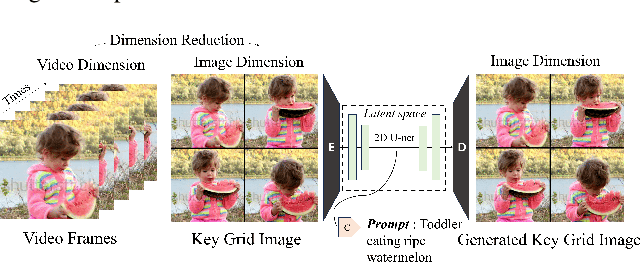

Abstract:Recent advances in the diffusion models have significantly improved text-to-image generation. However, generating videos from text is a more challenging task than generating images from text, due to the much larger dataset and higher computational cost required. Most existing video generation methods use either a 3D U-Net architecture that considers the temporal dimension or autoregressive generation. These methods require large datasets and are limited in terms of computational costs compared to text-to-image generation. To tackle these challenges, we propose a simple but effective novel grid diffusion for text-to-video generation without temporal dimension in architecture and a large text-video paired dataset. We can generate a high-quality video using a fixed amount of GPU memory regardless of the number of frames by representing the video as a grid image. Additionally, since our method reduces the dimensions of the video to the dimensions of the image, various image-based methods can be applied to videos, such as text-guided video manipulation from image manipulation. Our proposed method outperforms the existing methods in both quantitative and qualitative evaluations, demonstrating the suitability of our model for real-world video generation.
Sound of Story: Multi-modal Storytelling with Audio
Oct 30, 2023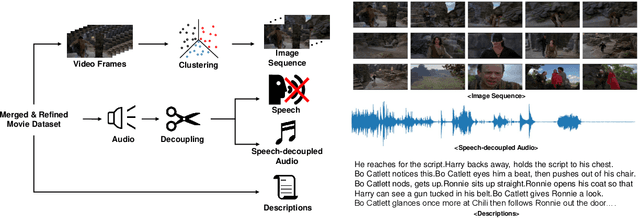

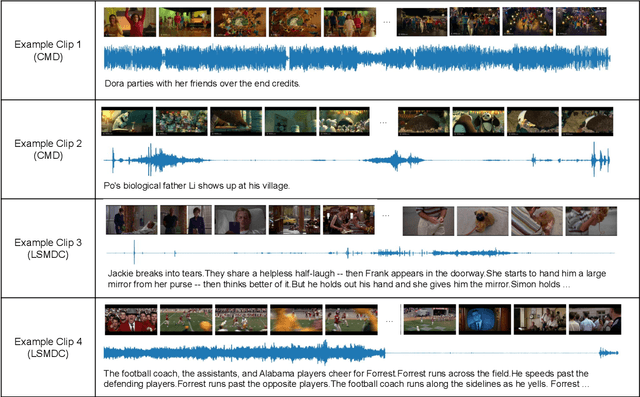

Abstract:Storytelling is multi-modal in the real world. When one tells a story, one may use all of the visualizations and sounds along with the story itself. However, prior studies on storytelling datasets and tasks have paid little attention to sound even though sound also conveys meaningful semantics of the story. Therefore, we propose to extend story understanding and telling areas by establishing a new component called "background sound" which is story context-based audio without any linguistic information. For this purpose, we introduce a new dataset, called "Sound of Story (SoS)", which has paired image and text sequences with corresponding sound or background music for a story. To the best of our knowledge, this is the largest well-curated dataset for storytelling with sound. Our SoS dataset consists of 27,354 stories with 19.6 images per story and 984 hours of speech-decoupled audio such as background music and other sounds. As benchmark tasks for storytelling with sound and the dataset, we propose retrieval tasks between modalities, and audio generation tasks from image-text sequences, introducing strong baselines for them. We believe the proposed dataset and tasks may shed light on the multi-modal understanding of storytelling in terms of sound. Downloading the dataset and baseline codes for each task will be released in the link: https://github.com/Sosdatasets/SoS_Dataset.
Effective Slogan Generation with Noise Perturbation
Oct 12, 2023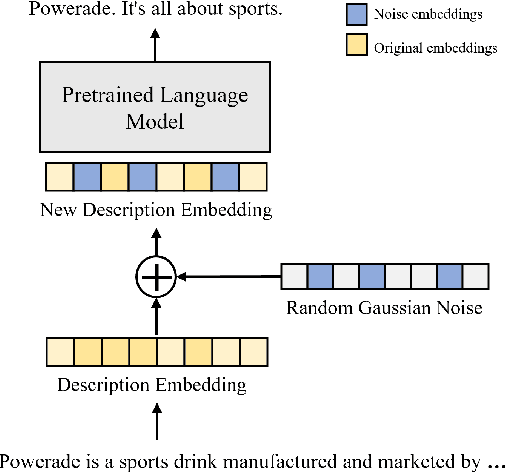


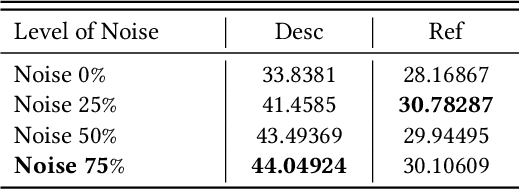
Abstract:Slogans play a crucial role in building the brand's identity of the firm. A slogan is expected to reflect firm's vision and brand's value propositions in memorable and likeable ways. Automating the generation of slogans with such characteristics is challenging. Previous studies developted and tested slogan generation with syntactic control and summarization models which are not capable of generating distinctive slogans. We introduce a a novel apporach that leverages pre-trained transformer T5 model with noise perturbation on newly proposed 1:N matching pair dataset. This approach serves as a contributing fator in generting distinctive and coherent slogans. Turthermore, the proposed approach incorporates descriptions about the firm and brand into the generation of slogans. We evaluate generated slogans based on ROUGE1, ROUGEL and Cosine Similarity metrics and also assess them with human subjects in terms of slogan's distinctiveness, coherence, and fluency. The results demonstrate that our approach yields better performance than baseline models and other transformer-based models.
Generating Realistic Images from In-the-wild Sounds
Sep 05, 2023Abstract:Representing wild sounds as images is an important but challenging task due to the lack of paired datasets between sound and images and the significant differences in the characteristics of these two modalities. Previous studies have focused on generating images from sound in limited categories or music. In this paper, we propose a novel approach to generate images from in-the-wild sounds. First, we convert sound into text using audio captioning. Second, we propose audio attention and sentence attention to represent the rich characteristics of sound and visualize the sound. Lastly, we propose a direct sound optimization with CLIPscore and AudioCLIP and generate images with a diffusion-based model. In experiments, it shows that our model is able to generate high quality images from wild sounds and outperforms baselines in both quantitative and qualitative evaluations on wild audio datasets.
 Add to Chrome
Add to Chrome Add to Firefox
Add to Firefox Add to Edge
Add to Edge